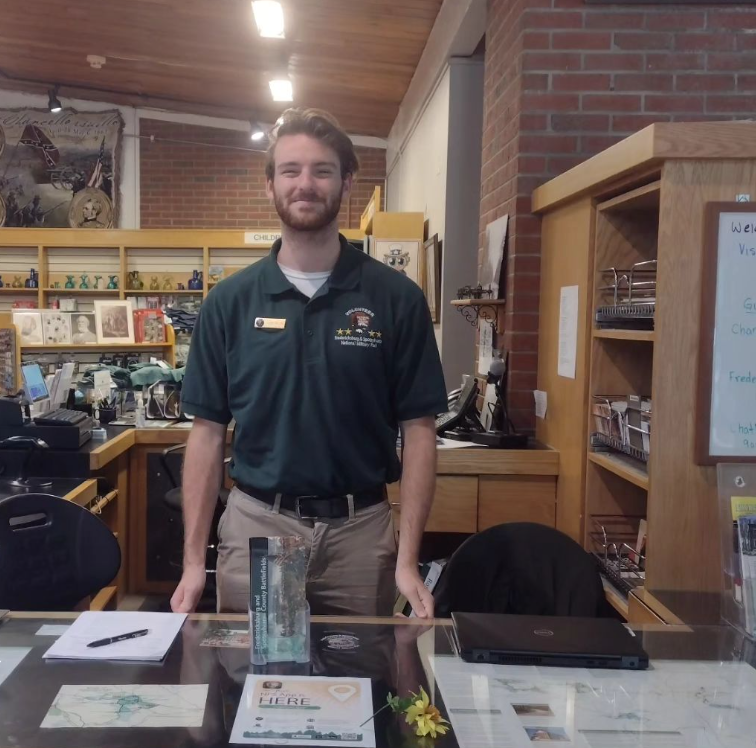Making History Public: My Summer on a Civil War Battlefield
by Jacob Phillips | | Monday, September 25, 2023 - 12:51

My name is Jacob Phillips, I’m a third-year history major at the University of Virginia, and I spent this summer as a Nau Center intern at Fredericksburg and Spotsylvania National Military Park. The time I spent at the park gave me a personal insight into the world of public history and connected me with amazing historians and fellow interns that I otherwise would never have met. Working at a Civil War battlefield also gave me the opportunity to be physically present at critical national landmarks and immerse myself in the study of the war.
An average day at this park was never typical or boring. We presented four programs every day for the public to attend and enjoy. Two of these programs were battle overviews, which were intended to give visitors a comprehensive understanding of the battlefield, battle, and political implications of the battle. The other two were wartime talks, which covered a wide variety of topics related to the area’s Civil War history. The park includes four battlefields: Fredericksburg, Chancellorsville/second Fredericksburg, the Wilderness, and Spotsylvania Courthouse. I spent most of my time at the Chancellorsville battlefield, and, by the end of the summer, I was giving a comprehensive and exciting battlefield overview to groups of twenty visitors at a time. I also created two wartime talks that I delivered at Chancellorsville. One focused on the memory of the wounding of General Thomas “Stonewall” Jackson and the other on the story of the escape of an enslaved man named Anthony Jones. I also created two wartime talks to give at the Fredericksburg battlefield. One complicated the myth of the Angel of Marye’s Heights (a Confederate sergeant who reportedly carried water to wounded Union soldiers) and the other detailed camp life for the average Civil War soldier.
The park rangers that worked with us daily provided us with a vast store of information and gave us great liberty in creating our wartime talks. I tended to cover the Lost Cause myth in all of my talks and discussed the relationship between the Civil War and the Civil Rights Movement in my Angel of Marye’s Heights talk. Because the park gave us freedom to create our own talks, I was able to share personal interpretations of history for members of the public, and I had great conversations with a wide range of people. I particularly loved this aspect of the internship. Being a university student has enabled me to critically examine interpretations of history with classmates and scholars specializing in different times and places. Working at the park, however, gave me the opportunity to hear very different and interesting interpretations. Visitors brought preconceived understandings of the Civil War and history in general that often originated from outside academia, and our conversations exposed me to different perspectives on history. From what events people considered important to the importance of history itself, visitors gave me a lot to think about in terms of how different people interact with the past.
While I had many great conversations during my battle overviews and wartime talks, most interactions took place inside the visitor centers at Chancellorsville and Fredericksburg. When visitors first arrive at the park, they often enter one of these two visitor centers, where an intern or ranger can provide them with maps and information. While many visitors had simple requests like the location of a landmark, several asked more comprehensive questions about the battle and the war itself. Others asked about ancestors who fought in the war, often hoping to find out where they had been deployed on the battlefields. I particularly enjoyed getting this request. We would find the ancestor’s unit and commanding officer, and, with that, we could approximate his location on our battle maps. This process was a ton of fun, because we got to connect people with their ancestors and the history of the park, giving them a personal connection to the place we were in and the events that took place there.
Along with giving me the opportunity to learn from the public, the park introduced me to interns from several other universities. I worked with one or two of these fellow interns every day. They all became great friends, and I could always count on having an interesting conversation about Civil War history every day with these colleagues. Between my fellow interns, the park rangers, and the public, I could always expect to learn something new and experience this internship in a unique way every day. Working at Fredericksburg and Spotsylvania National Military Park was beyond enriching, and I am more than happy that I spent my summer living and learning there.
